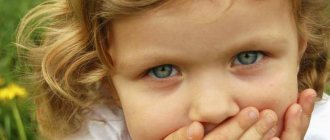Teaching a small child under one year to speak: isn’t it too early?
It is possible and necessary to develop a child’s speech already in infancy. In pediatrics, this period is called pre-speech. When a baby uses his senses to receive information about the world around him, motivation for his first words arises. Therefore, the task of parents is to develop the baby’s visual, auditory and tactile analyzer.
The baby's eyes should constantly observe interesting colorful objects around. For example, this is a mobile in a crib with rotating animals, rattles and other toys of various structures. In addition to contemplation, the child must touch these things with his hands.
The development of his auditory, visual and tactile analyzers will help bring the baby closer to his first words.
But a much more important component of success is continuous communication with the child. Moreover, we are not talking about the usual lisp, verbal admiration for the beauty of one’s child. Replies should be meaningful - when mom speaks, she comments with words all her actions in as much detail as possible (for example, “mom is cooking porridge,” “what a beautiful pan,” “what a delicious porridge,” “now you will eat porridge,” etc. ). At the same time, phrases should not be “dry” - you need to speak in complete sentences, use more adjectives and verbs.
Some mothers are embarrassed that this will be a “one-man show,” because the baby cannot answer yet. Others willingly talk to their tummy even during pregnancy.
Simple conditions that will help a baby under one year old to speak quickly and with pleasure
Communication options may also be as follows:
- Tell your child about your immediate plans (“Now I’ll stroke your little undershirts and we’ll go for a walk”).
- Ask your little one questions and answer them yourself (“What rompers do you want to wear for a walk? Probably these, now we’ll put them on”).
- Closer to one year, you can already practice the simplest speech games (the adult himself still answers the question):
- Mom names different words, and when she talks about something edible, we loudly exclaim “Am!” and pretends that he wants to bite the baby. After several such games, perhaps he himself will answer “Am!”;
- onomatopoeia game. The mother asks the child: “How does the cat scream?” (dog, frog, donkey, etc.). Then she answers, and as cheerfully and emotionally as possible. Surely the baby will laugh in response and sooner or later he will begin to make characteristic sounds;
- game "Where is the object?" Mom asks the baby about the location of some thing and again answers her own question (for example, “where is the bottle - here it is”).
The most important thing is continuous communication with the baby, and it doesn’t matter that he cannot yet verbally respond to his mother
An important point in communication is to initially tell the child the correct forms of words, without distorting them; you should not call all things by diminutive names (“hair”, “pants”, crib”, etc.). In addition, you should try not to accustom the baby to the pacifier, because it interferes with the articulatory apparatus to develop correctly.
If you want your baby to talk faster, wean him off the pacifier
It is imperative (literally from birth) to read children's books to your baby, while showing large colorful pictures. Of course, at first the child will not understand the meaning of the text, but he will hear the voice of a loved one and lively figurative speech.
You can and should read books almost from birth
It is also useful to sing songs, for example, lullabies, tell simple poems, nursery rhymes. If mom doesn’t know how to sing, store-bought CDs will come to the rescue.
Already in infancy, you should massage your baby’s hands and fingers. This stimulates fine motor skills, which are directly related to speech development. Closer to the year, you can offer games with flour, semolina - immerse a toy in it and invite the baby to find it.
To develop speech from an early age, you need to stimulate fine motor skills - massage the baby’s fingers and hands
As a result of such systematic exercises, probably after six months the baby will say his first simple words (“mother”, “give”, etc.).
Video: proper stimulation of speech development from birth to one year
Video: an adult encourages a baby to talk
Tips for parents
You can talk to a 2-year-old child only after finding out the exact reason for his silence.
Experts advise parents not to panic right away, but to take the following steps:
- Make an appointment and visit a specialist : psychiatrist, neurologist, defectologist. Only with their help can the presence of physical and mental disorders be excluded. If deviations are identified, then everything possible must be done to eliminate them.
- Create an atmosphere with your family . Try to clarify all relationships once and do everything possible so that there are no scandals and conflicts in the family. Any child always needs love, attention and care. Every child should always feel that he is loved and adults need him like air. The child’s psyche is designed in such a way that if he sees adults arguing, he always blames himself for it.
- You always need to pay attention to your baby , even if you are very tired or have difficulties. In order for a child’s psyche to develop properly, he simply needs to know that he will be given attention when he wants it.
- Find time every day for your child to properly develop his speech. You need to choose easy and simple gymnastics that will have a positive effect on expanding his vocabulary. Such tasks give the child the main thing - communication with adults.
- Organize the correct daily routine . To develop correct speech, it is important to follow a clear daily routine, which includes: proper nutrition, walks outside, alternating wakefulness and sleep. All this will allow the baby to develop properly and strengthen his health.
- Read aloud to your child. If a child does not speak or speaks poorly, then you need to pay more attention to him and spend time together actively and cognitively. You need to play with him more often, do cleaning, get a pet, and spend time outdoors.
- Develop fine motor skills. You can buy special toys or ask your child to help make dumplings. You can also create crafts from plasticine.
A visit to kindergarten will help a child talk at 2 years old. There the child will be surrounded by peers, listening to them, he will also want to communicate with them.
Classes for 1–1.5 years: mastering syllables
When working with a baby after a year, a mother can use the same methods, only making them more complicated. At this age, the child usually reacts verbally to dialogue: even if at first it is just individual syllables, you need to be encouraged to repeat them until whole words appear.
However, it is important not to overdo it, so that the child does not become stubborn.
Reading books and discussing illustrations are becoming increasingly important. The mother actively asks the child questions about the content of the pictures, and constructs them so that the answers are not only nouns (“Who is this?”), but also adjectives and verbs (“What color is a banana?”, “What does the car do?”). Oppositions are introduced into the baby’s speech: “this flower is small, and this one is big.”
To stimulate a child’s speech, you do not need to react to his body language or facial expressions (for example, a baby asks for a drink and at the same time folds his lips into a tube). Mom needs to pretend that she doesn’t understand what her child wants. At the same time, you don’t need to bring the baby to tears, but help him with leading questions.
It is necessary to encourage the baby to verbally indicate what he wants, without specifically understanding his gestures
At the same time, there is no need to encourage simplifications in children's speech, for example, “bibika” instead of “machine” or “kakleta” instead of “cutlet”.
You can give specific examples of games and exercises for a given age:
- Finger massage is replaced by exciting finger gymnastics (on the Internet you can find a huge number of options on any topic).
- In addition to games with semolina and flour, there are also manipulations with small objects (necessarily under the supervision of an adult), rolling pencils, balls, small balls, etc. on the table. At one and a half years old, you can already offer your baby plasticine, plastic dough, etc.
At one and a half years old, you can already offer your baby plasticine - modeling perfectly develops fine motor skills
- Word game "Correct the mistake." The mother says a sentence or phrase from a fairy tale known to the child and deliberately confuses the words (for example, “the chicken laid an egg, but not a simple one, but a blue one” or the duck says “meow-meow”).
- "Magic bag" The adult invites the baby to take out toy animals from an opaque bag and name them.
- “What does it sound like?” The child is invited to voice a variety of objects in the surrounding world, for example, “how is it raining?” or “how do the feet stomp?” At first, let him answer simply with syllables (“ka”), then with onomatopoeic words (“kap”). Subsequently, more complex words will appear (“what does rain do is drip”).
- With a one-year-old baby, you can already practice articulatory gymnastics, and you don’t need to exhaust him with the same exercises every day, but change them. For example, the following options are suitable: blow out a candle (real or imaginary), blow into a toy pipe, on a piece of cotton wool in the palm of your hand, lick imaginary jam on your lips, show the tongue of an elephant’s trunk (stretch out your lips with a tube).
Articulation gymnastics for a small child should be fun and exciting
- Playful training of vowel sounds: show how a baby cries (“a-a-a”), how surprised we are (“o-o-o”), how a plane flies (“oo-oo-oo”).
At this age, it is important to protect the baby from the TV, in comparison with which live human speech turns into background. Special cartoons that develop speech can be shown to the child at an older age (3 years).
Video: classes for speech development with a one-year-old child
Video: a mother shares her experience of how her daughter developed her speech after a year
How to teach a child to say the letter Sh
Cases when a baby poorly, or even does not pronounce some letters of the alphabet at all, are very common.
Mothers worry about how to teach their child to correctly speak (hissing) sounds that are difficult for him. You shouldn’t worry too much about your baby’s lisp, since he develops correct pronunciation by the age of 5-6. We will now discuss how to teach a child to say the letter “Sh” without the help of specialists. Before you start making the letter “Ш”, you need to do articulation gymnastics. A warm-up is used for the lips (tube, smile) and tongue (“tongue-cup”, clicking).
Speech therapists advise first developing the pronunciation of a single sound. You should ask the baby to say “shhhhhhhh”, hiding his tongue behind his teeth.
When the isolated sound “Ш” is fixed, you can select simple words with the letter “Ш”, tongue twisters, nursery rhymes, and poems.
Working with a two-year-old child: learning words, constructing phrases and short sentences
If you follow the previously mentioned recommendations, then by the age of two the child will already speak quite well (he can construct phrases of 3-4 words on his own). But each child has his own pace of development, and sometimes there are silent children who at this age practically do not speak (very little or in their own “childish” language), but at the same time they well understand everything that is said.
At two years old there are quite a lot of silent children who understand everything well, but hardly speak
The absence of speech in this case is not associated with any pathologies, but simply with the isolation of the child’s development. There are guys who accumulate information for a long time, and then immediately start talking in whole phrases. A hereditary factor may play a role (mom or dad also spoke late), or the baby is simply lazy, and the parents do not take special action.
To change the situation, adults should follow these recommendations:
- Talk to your child as much as possible, and in whole sentences.
- Constantly read books and talk about them.
- Show pictures on a variety of topics (vegetables, fruits, animals, transport, birds, etc.) and together name the object depicted.
A two-year-old silent child needs to be shown various thematic pictures and talk about them
- Offer exercises and games to develop fine motor skills, including modeling from plasticine, special dough, and finger painting.
- Play finger theater (characters are put on the child’s fingers), play poems using finger gymnastics.
A good way to stimulate fine motor skills is finger theater
- More often arrange for your child to communicate with older children or peers who already speak well.
- It is emotional to tell your child rhythmic and simple poems (for example, A. Barto).
- Arrange dramatization games where characters (dolls, everyday objects, products, etc.) must talk.
How to teach a child to say the letter P: speech therapy exercises
Many parents are interested in the question of how to teach their child to say the letter “r”. To successfully develop and master the technique of staging, you must follow the following rules:
- Gradualism.
- Child's interest.
- Regularity of classes.
By doing them, you will achieve dramatic changes, and your baby will begin to take his first steps in pronunciation. But this is not enough, since this letter is very difficult and it is not so easy to pronounce it.
To accelerate the development of correct pronunciation, it is necessary to train the muscles of the speech apparatus
Effective speech therapy exercises for the sound “r” that will bring the desired result:
- First, the sound “r” must be pronounced separately (growling).
- Training in the correct production of the “r” sound in syllables and simple words.
- Automation of pronunciation using tongue twisters, poetry and everyday speech.
For such a simple technique to help, it should be performed daily, but if the baby refuses, then there is no need to force it.
Possible problems that require contacting a specialist
As you know, each child develops at its own pace. Meanwhile, there are certain average standards for speech development that parents can focus on:
- 3–6 months. The baby tests his articulatory apparatus in action, “plays” with sounds (humming, hooting).
- 1 year. The first words appear (“mom”, “dad”, “give”, etc. - usually up to 10 words).
- 2 years. The baby builds simple phrases of 3-4 words. Active vocabulary is 150–300 words.
- 3 years. The child speaks quite a lot, in common sentences (4-5 words), and recites poems by heart. Active vocabulary - 400–800 words.
- 4 years. Active vocabulary - 1300–2000 words. All parts of speech are used in speech.
- 5 years. The active vocabulary reaches 5000 words, new words are quickly memorized. Coherent speech is well developed.
Today, many children begin to speak much later than their peers 20 years ago. This is primarily due to social factors: modern children spend a lot of time in front of the TV from an early age and begin to get used to gadgets early; adults themselves are constantly busy and do not encourage the child’s speech activity. However, in some cases, a significant lag from these standards may be due to quite serious physiological or mental reasons:
- Problems during pregnancy: hypoxia in the fetus, infections suffered by the woman, stress, Rh conflict between mother and fetus.
- Birth injuries: skull deformation during childbirth, umbilical cord entanglement, etc.
- Congenital hearing problems in a baby.
- Congenital anomalies of the structure of the speech apparatus.
- Severe infectious diseases suffered in infancy (meningitis, encephalitis, purulent otitis media, etc.).
- Unfavorable social and living conditions, pedagogical neglect. There is another option - overprotection (when the child’s every desire is predicted, so he simply has no need to speak), excessive lisp (the baby does not strive to improve his speech).
Underdevelopment of speech may be associated with problems during pregnancy and childbirth, for example, a child was born entangled in the umbilical cord
Parents should always be very attentive to their baby in order to suspect possible deviations and contact a specialist (neurologist, ENT specialist, psychologist, etc.). For example, if an infant does not respond to sounds, it is likely that he has hearing problems. In this case, he is unlikely to start talking on his own, because he simply does not hear the sounds of the surrounding world. Another option: if a grown-up baby does not respond to his name or words addressed to him, does not look an adult in the eyes, prefers solitude, he may have autism. This is a mental disorder in which a person avoids social contacts with the outside world.
Video: what problems can negatively affect speech development, signals that should alert you
How to teach a child to say the letter L
You need to know in advance how to teach your child to say the letter “L” in order to prevent incorrect speech from becoming a habit. After all, correcting is always more difficult than teaching.
In order to put the correct articulation of the sound “L”, you need:
- Show clenched teeth, stretching your lips into a smile (this will make it easier to pronounce a hard sound).
- The tip of the tongue can press on the upper teeth or alveoli.
- Make sure that the tongue is not adjacent to the side teeth, thereby allowing air to pass through.
To correctly pronounce this sound, you need to repeatedly train it in the syllables: LO-LY-LA-LU OR AL-OL-UL-YL.
Age characteristics
The formation of language skills occurs in several stages, so parents should know what speech skills a child should have at a certain age in order to consult with a specialist in time in case of problems.
Stages of speech development:
- The first year of life - at 1.5 months, the baby makes vowel sounds (“a”, “u”, “s”). At this time, the formation of the intonation system occurs. At six months the baby begins to babble and even pronounce certain syllables (“ma”, “ba”, “dya”), and by 12 months he is already trying to speak basic words. The function of speech understanding is formed precisely during this period, and after that the process of vocabulary replenishment begins. By the way, the first thing the baby says is not “mom,” as many people think, but “give.” According to statistics, this is typical for 60% of children.
- The second year - during this period the baby begins to understand the speech of adults well. He listens carefully to what others say to him and tries to repeat some words after them. The baby is already talking, but only in his own language. These words are incomprehensible to adults, but parents eventually learn to recognize the baby’s peculiar speech. You can teach a child to talk at 1.5 years old by repeating the same words over and over again, and by the age of 2 years the baby will already be able to pronounce individual phrases (“Mom, give me”, “I want yum-yum”, etc.).
- Third year - at this age, noticeable progress appears in the development of verbal skills. The child begins to form sentences and can engage in meaningful dialogue. During this period, you should try to read to your baby as much as possible, sing songs with him and constantly communicate.











